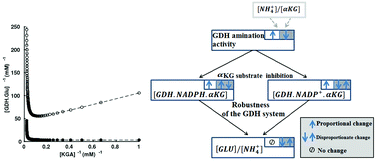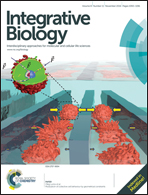Robust regulation of hepatic pericentral amination by glutamate dehydrogenase kinetics†
Abstract
Impaired glutamate dehydrogenase (GDH) sensitivity to its inhibitors causes excessive insulin secretion by pancreatic beta-cells and defective ammonia metabolism in the liver. These symptoms are commonly associated with hyperinsulinism/hyperammonemia syndrome (HI/HA), which causes recurrent hypoglycaemia in early infancy. Hepatic localization of GDH amination and deamination activities linked with the urea cycle is known to be involved in ammonia metabolism and detoxification. Although deamination activities of hepatic GDH in the periportal zones of liver lobules and its connection to the urea cycle have been exhaustively investigated, physiological roles of GDH amination activity observed at pericentral zones have often been overlooked. Using kinetic modelling approaches, here we report a new role for hepatic GDH amination kinetics in maintaining ammonia homeostasis under an excess intrahepatocyte input of ammonium. We have shown that α-ketoglutarate substrate inhibition kinetics of GDH, which include both random and obligatory ordered association/dissociation reactions, robustly control the ratio between glutamate and ammonium under a wide range of intracellular substrate variation. Dysregulation of this activity under pericentral nitrogen insufficiency contributes to the breaking down of ammonia homeostasis and thereby can significantly affect HI/HA syndrome.


 Please wait while we load your content...
Please wait while we load your content...